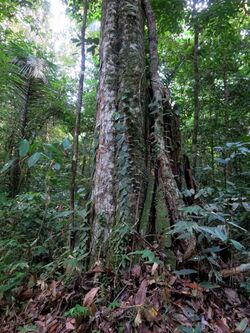Biology:Chlorocardium
| Chlorocardium | |
|---|---|

| |
| Chlorocardium rodiei | |
| Scientific classification | |
| Kingdom: | Plantae |
| Clade: | Tracheophytes |
| Clade: | Angiosperms |
| Clade: | Magnoliids |
| Order: | Laurales |
| Family: | Lauraceae |
| Genus: | Chlorocardium Rohwer, H.G.Richt. & van der Werff |
| Species | |
| |
Chlorocardium is a genus of the family Lauraceae. It contains only three species, C. esmeraldense, C. rodiei and C. venenosum, and is native to northern South America. The name Chlorocardium means green (chloro-) heart (cardia), referring to the wood.
They are trees up to 40 m high, mostly 30 m high, and are hermaphrodites. They are slow-growing canopy evergreen trees and have a valuable timber. The wood and bark are pleasantly scented. They are present in Peru, Ecuador, Colombia, and the Guiana Shield (in northeastern Brazil, Venezuela (Amazonas, Bolívar and Delta Amacuro states), Guyana, Suriname and French Guiana).[citation needed]
The species are heavily used by the timber industry. This causes a shortage of mature trees. Their timber is of great commercial value and much exploited, but C. rodiei is able to produce sprouts from more than 50% of stumps.[1]
Ecology
Trees of this genus grow in evergreen tropical forests. The ecological requirements are those of moisture precipitating almost continuously in cloud-cover for much of the year.
The fruit, a drupe, is an important food source for birds.
The common name in Guyana is greenheart or greenhart.
References
External links
- Antarctic vessel the 'Hero' takes compression much better than steel. Built from green heart wood. "She's like a Sherman tank." [Portland Magazine. 8 November 2012]
Wikidata ☰ Q2391012 entry
 |

